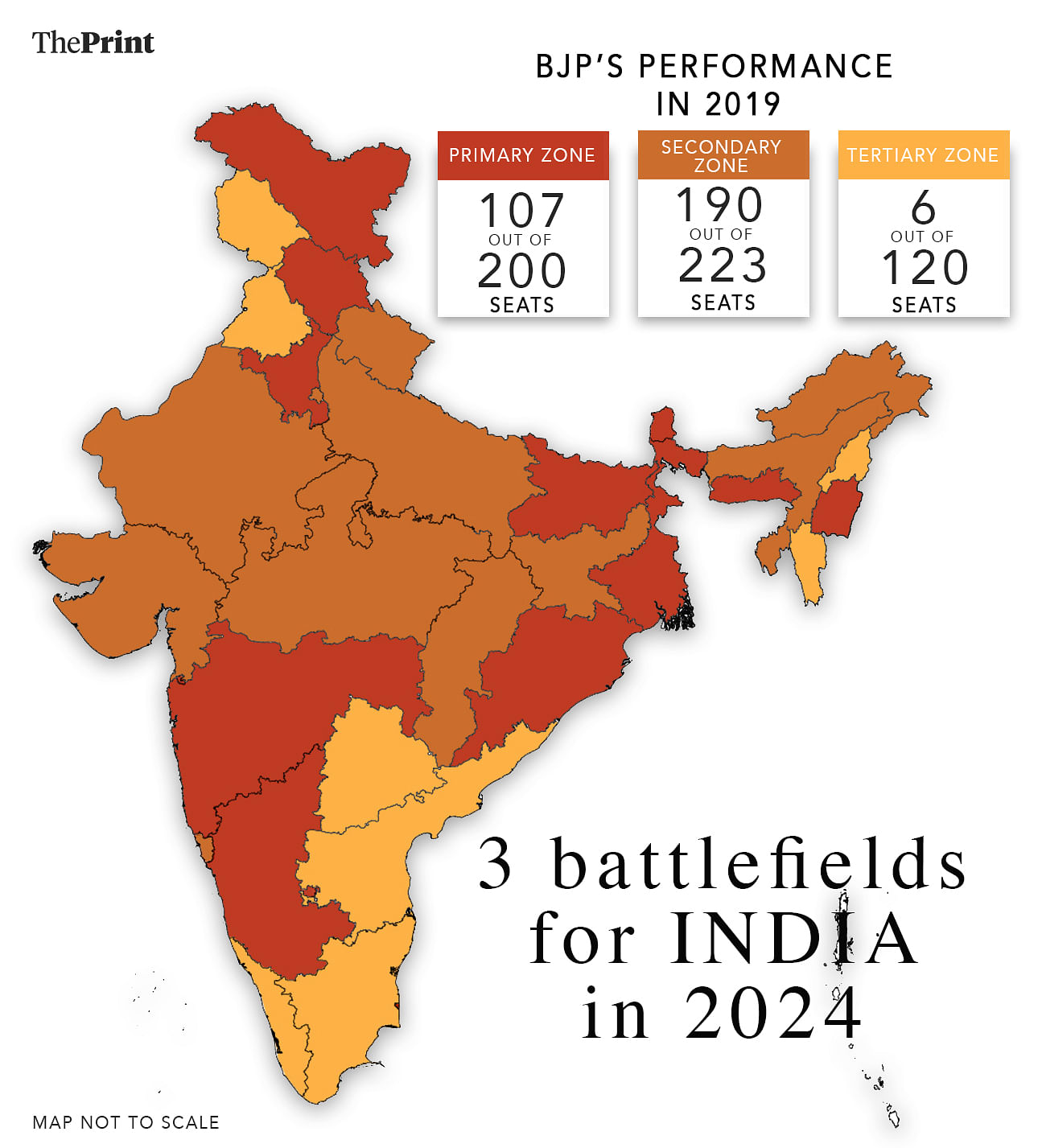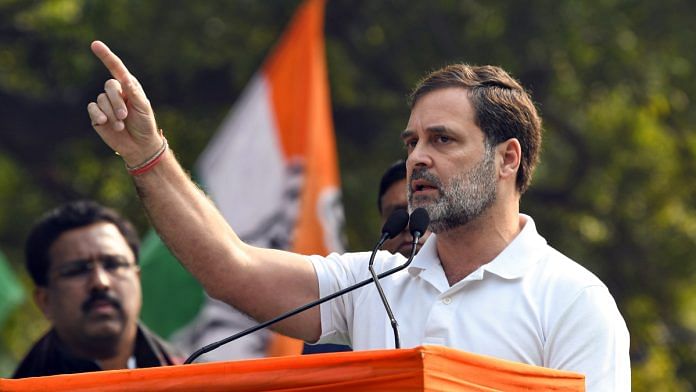Can the BJP be halted in its march towards a third consecutive victory? Is there a strategy to stop the ruling party from touching the majority mark in 2024? Most political observers and independent analysts seem to have given up. So have many opposition leaders.
I disagree. Not because I believe in last minute miracles. Not because I am confident of a majority for INDIA. I do not disregard the signals of the BJP’s recent victory in the three Hindi-speaking states. No matter what my assessment of the Narendra Modi government, I cannot dismiss the opinion poll evidence in favour of the prime minister’s popularity.
Yet I disagree with the view that 2024 is a ‘done deal’. I have learnt to read evidence for what it is, minus the hype orchestrated around it. True, recent electoral outcomes and survey evidence shows that a dramatic upset for the BJP—a shock defeat by a big margin, as in 2004—is improbable. At the same time, the evidence does not rule out the possibility of the BJP falling well short of the 273 mark without INDIA securing a majority. If the opposition has a strategy, with imagination and political will to execute it, this outcome is still within the range of possibility. As of today, 2024 is still an open race.
Here is the outline of this strategy for the opposition parties. Let us divide the electoral battle of 2024 into three zones or battlefields: primary, secondary and tertiary. The basic idea is to devise different tactics for these three different battles.

Also read: EVM debate has a solution. And it’s neither the ballot paper nor INDIA’s new demand
3 battlefields and how to fight them
Let us begin with the tertiary zone, where the BJP is a marginal electoral force. The BJP is not among the top two contenders in the southern states of Kerala, Tamil Nadu, Andhra Pradesh, and Telangana. Add to it Punjab, Kashmir, Mizoram, Nagaland and Lakshadweep and the list adds up to 120 Lok Sabha seats. Last time, the BJP won only 6 seats here—4 in Telangana and 2 in Punjab. In the last five years, the BJP has not made much inroads in these regions. Its hopes for a repeat of Bengal did not fructify in Telangana. In the normal course of things, it would find it difficult to retain its 6 seats in this zone, unless there is an overt or covert alliance with Akali Dal in Punjab and BRS in Telangana.
‘Block and contain’ would be the right approach for the INDIA coalition here. There is no need for an anti-BJP coalition in these states. The focus should be on those few seats where the BJP might attempt a breakthrough: Thiruvananthapuram in Kerala, or Kanyakumari and Coimbatore in Tamil Nadu, for example. The BJP can be blocked here through focused campaigns by opposition parties and civil society and, if need be, a small transfer of votes between INDIA partners. Besides, the attention should be on containing the tally of the BJP’s current and possible allies. It should not be difficult to keep the BJP at its current level in this zone.
The secondary battlefield comprises those 223 seats where the BJP is the dominant party and is hard to dislodge in the next three months. This is mainly the Hindi heartland, including Uttar Pradesh, Uttarakhand, Madhya Pradesh, Chhattisgarh, Jharkhand, Rajasthan, and Delhi. Add to it Gujarat, Assam, Jammu region, plus smaller states like Tripura, Arunachal Pradesh, and Goa and you have the entire ‘hegemonic zone’ where the BJP registered 85 per cent strike rate last time—190 out of 223 seats to be precise. Post-2019 assembly elections and opinion polls indicate that the BJP is still the dominant party in this zone. But we must note that the BJP needs nothing short of a sweep here. If its strike rate comes down even marginally, say from 85 to 75 per cent, this could upset the ruling party’s majority calculus. Here lies the opportunity for the opposition.
The opposition could adopt the ‘chipping away’ approach here. This would involve focusing its entire energy into a small number of targeted constituencies. For example, Gujarat continues to be a BJP bastion, but the Congress can target 4 seats, mainly in the tribal belt. In Rajasthan, the Congress has a fair chance in half-a-dozen seats in the north east, and a couple of tribal seats in the south if it ties up with the Bharatiya Adivasi Party. Uttar Pradesh is tough, yet the SP-RLD-Congress combine can target up to two dozen seats in the state. In these states, the opposition does not need to snatch the votes away from the BJP; all it needs is to retain its own voters in the recent assembly elections, and that too in a few pockets. Here again, except Uttar Pradesh, the opposition does not need a grand alliance; some carefully chosen local alliances are the need of the hour. If the opposition targets about 50 such constituencies, it can snatch about 20-25 seats from the BJP in this zone.
This strategy would allow INDIA coalition to focus on the primary battleground, the remaining 200 seats where the BJP did very well last time, but may be vulnerable now. The reasons vary. Maharashtra and Bihar have seen political reconfiguration and fresh alliances that provide an opening to the INDIA coalition. West Bengal, Himachal Pradesh, and Karnataka have seen elections since 2019 where the BJP has faced serious reverses. The farmers’ movement has changed the political mood in Haryana. In Odisha, the BJD may not be as willing to gift Lok Sabha seats to the BJP as it was in 2019. You can add Sikkim, Manipur, Meghalaya, and Union territories like Ladakh, Chandigarh, and Pondicherry to this list. The BJP had bagged 107 of these seats — 147 if you include its allies of 2019.
Here the opposition has to go for a full blown push, a frontal assault that aims at substantial reversals for the ruling party. This requires INDIA to work as a full and functional alliance, not just formulate a seat-sharing mechanism. Bihar and Maharashtra necessitate the largest possible alliance (including Vanchit Bahujan Aaghadi in Maharashtra and the CPI-ML in Bihar). In Bengal, it would involve an end to the Congress-TMC fracas and an informal understanding with the CPM. Congress needs to settle small alliances or adjustments with new forces (for instance, breakaway faction of JDS) in Karnataka, Haryana, and Himachal Pradesh and reclaim the oppositional space in Odisha. This must be followed by a joint and vigorous campaign by all the INDIA leaders. If the INDIA coalition can get its act together, the BJP can still be made to lose around 30-40 seats in these states.
If we add the lower end of the range of damages that can be inflicted in these three battlefields, we are looking at a cumulative loss of 50 (0+20+30) seats for the BJP that pushes it to 253 seats, 20 short of the majority mark. With some luck, the deficit may be hard for the BJP to plug with its depleted allies. This may not be the most likely scenario, but one that cannot be ruled out at this stage.
And now the fine print, the terms and conditions under which the present analysis holds. It assumes that the next few months will not see a big surge in the BJP’s vote share—a substantial shift of those who voted for the opposition parties in the assembly elections—of the kind seen in the run-up to 2019. This assumption would hold only if the opposition does not give a walkover, if INDIA manages to present itself as a coherent and viable alternative, and if it offers an agenda for the country that is attractive and credible.
Is that too much to ask or assume? I leave this to you.
Yogendra Yadav is National Convener of the Bharat Jodo Abhiyan. He tweets @_YogendraYadav. Views are personal.
(Edited by Prashant)




Your greedy assumptions/analysis will not work out. On the contrary it will work only to BJP’s favour. They have strengthened their base at TN, where they may increase their seat and vote share and occupy the second position.
A party pulling off the greatest election upset using a masterful strategy by Yogendra Yadav would be like a moribund mid-size company averting a collapse and becoming profitable by using the advice in a PPT presentation prepared by 24 year-old consultants from BCG.
Andolanjeevi completely forgot about Ram Temple Inauguration. It will definitely surge Modi, BJP popularity.
What kind of analysis is this.
Self anointed oracles, assuming and expecting that people of India have no agency and can not decide whom to vote for. Only these oracles have the right to decide on behalf of the country whom the people should vote for.
Yogendraji
Isnt this like playing for a draw, knowing fully well that you cannot win the match? Is this the right way to approach the election?